The 1976 Republican Convention
Page 1 2
Related readings:
1976 Democratic Convention analysis and photos.
1976 Republican Convention analysis.
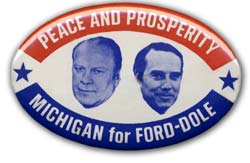 The 1976 Republican Convention that met in Kansas City August 16-19 was the most divided since 1952. Former California Governor Ronald Reagan challenged incumbent President Gerald R. Ford in the primaries and came close to winning.
The 1976 Republican Convention that met in Kansas City August 16-19 was the most divided since 1952. Former California Governor Ronald Reagan challenged incumbent President Gerald R. Ford in the primaries and came close to winning.
Such a challenge was possible in the Republican 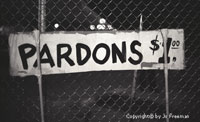 Party only because the man elected in 1972, Richard Nixon, had resigned and Ford had become President without being elected by any voters except those in his Michigan House district. Indeed Reagan came so close that it wasn’t until a Tuesday night roll call vote on an amendment to the proposed Rules that it was clear that Ford would win the nomination, but not by much.
Party only because the man elected in 1972, Richard Nixon, had resigned and Ford had become President without being elected by any voters except those in his Michigan House district. Indeed Reagan came so close that it wasn’t until a Tuesday night roll call vote on an amendment to the proposed Rules that it was clear that Ford would win the nomination, but not by much.
In this fractious atmosphere women and women’s issues took a back seat to the Presidential campaigns. Feminists, acting through the Republican Women’s Task Force (RWTF) of the National Women’s Political Caucus (NWPC), were part of the Ford campaign. The anti-feminists, acting through Phyllis Schlafly’s STOP ERA, were Reagan supporters.
These two groups fought over whether support for the Equal Rights Amendment should remain in the Republican Party Platform. It had been in the Platform from 1940 until 1964, when it disappeared without actually being removed. Even though all of the candidates for the 1964 Republican nomination (Goldwater, Rockefeller, Scranton, Smith) supported the ERA, a decision to write a very brief platform that year caused removal of many planks which had traditionally been in the Platform. In 1972, Republican feminists put it back in without opposition. Serious opposition to the ERA emerged the following year as the states debated whether or not to ratify the proposed Constitutional amendment.
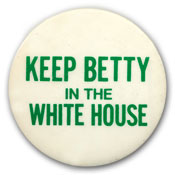 Both Ford and Reagan had supported the ERA when it was sent by Congress to the states on March 22, 1972. Between then and 1976, Ford strengthened his support. His wife, Betty, was an ERA champion. While Governor of California, Reagan had also supported the ERA. When he decided to run for the 1976 nomination he switched sides to court the large number of conservative women who did not like it.
Both Ford and Reagan had supported the ERA when it was sent by Congress to the states on March 22, 1972. Between then and 1976, Ford strengthened his support. His wife, Betty, was an ERA champion. While Governor of California, Reagan had also supported the ERA. When he decided to run for the 1976 nomination he switched sides to court the large number of conservative women who did not like it.
The first battle over keeping the ERA in the Republican Party Platform was fought the week before the convention in the Platform Subcommittee on Human Rights and Responsibilities. Testifying for the ERA were NWPC President Audrey Colom, and RWTF organizers Pat Bailey, Betsy Griffiths and Pat Goldman. Elizabeth Chittick, herself a Republican, spoke for the National Woman’s Party, which had proposed the ERA in 1921 and had been pursuing it ever since. Phyllis Schlafly, who only opposed the ERA after she discovered grassroots resistance to it among her own followers, asked the Subcommittee to remove the ERA from the Republican Platform.
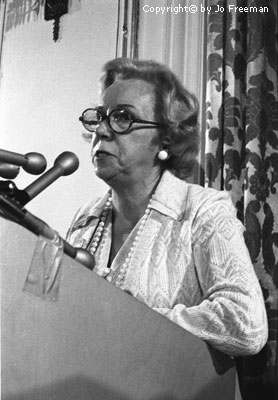 Elizabeth Chittick |
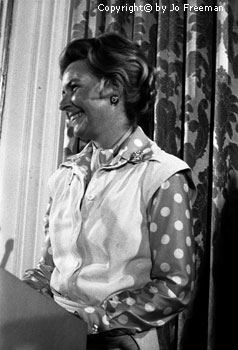 Phyllis Schlafly |
|---|
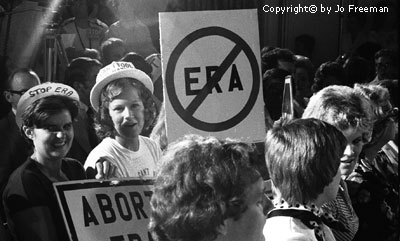
STOP ERA won the battle of the signs. They filled the room and greeted those outside.
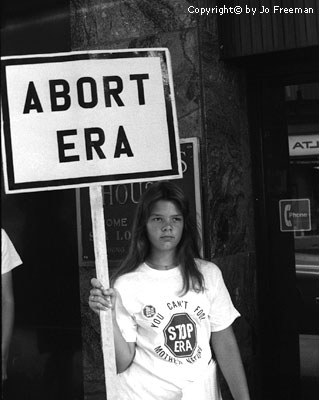
The RWTF had counted their votes and knew they could win by 8 to 7. However, when it came time to vote, one of their votes was missing. Consequently, when Subcommittee member Joan Lipsky of Iowa moved to substitute "pro-ERA" language for the anti-ERA proposal initially moved by Frances Wideman of Alabama, the resulting tie defeated the "pro" proposal.
Joan Lipsky
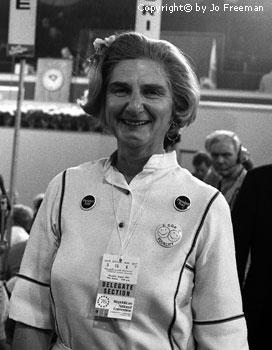
This allowed the press to headline their stories "ERA defeated" when a different strategy would have led to "ERA opponents defeated." When missing member Rep. Silvio Conte (Mass.) showed up the next day, the defeated "pro" language could not be reconsidered under parliamentary rules, and only "anti" or "no position" proposals were left to be voted on. One of the preceding day's "pro" votes was that of Joe Usry, a fundamentalist minister from Oregon, who had stated that he was personally opposed to the ERA but would vote for it because he was committed to Ford. During the night the "antis" convinced him that a "no position" plank would be consistent with both his conscience and his candidate commitment. The "no position" won 8 to 7.
The subcommittee votes
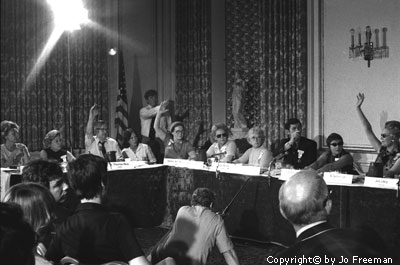
This defeat shook the Ford campaign in Washington, which issued a strong public statement supporting the ERA. His campaign operatives told their delegates on the full Platform Committee that Ford couldn't afford an ERA defeat. In the meantime, RWTF members were doing background checks on other uncertain votes in the Committee to find out what would affect their votes. The RWTF and the Ford campaign jointly found enough Committee members more interested in their political futures than in the ERA to win a bare 51-47 victory and keep the ERA in the 1976 Republican Party Platform.
The Platform Committee

In the meantime the Kansas City chapter of the National Organization for Women organized their own commentary on the Republican Platform. They brought signs into the Platform Committee deliberations and held them up when the ERA was being voted on. One anti- sitting in front of them stood up to partially block their signs.


Later KC NOW members stood on the sidewalk passing out leaflets and displaying signs on the women’s issues that they thought the Republican Party platform should be addressing, specifically rape and battering.
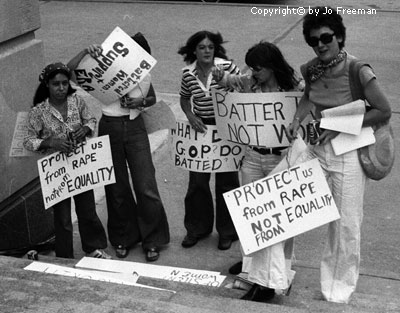
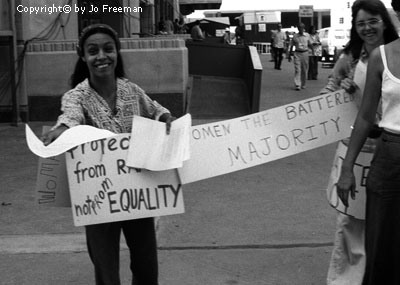
Over the weekend between the Committee deliberations and the Convention, National NOW came to town. Finding itself unwanted by the Republican feminists, NOW President Karen DeCrow led a small march down the sidewalk and left.
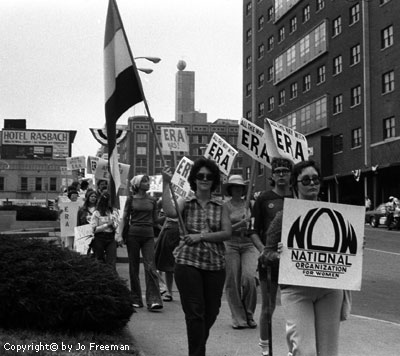
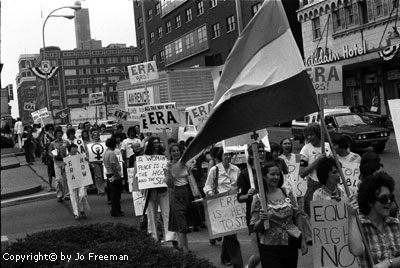
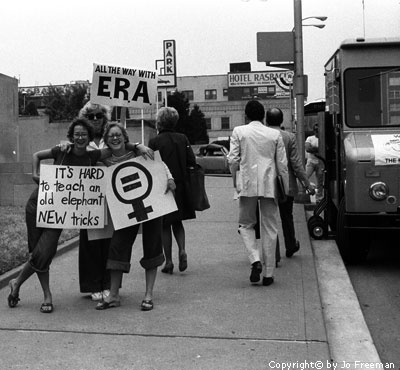
Page 1 2
Books by Jo | What's New | About Jo | Photos | Political Buttons
Home | Search | Links | Contact Jo | Articles by Jo